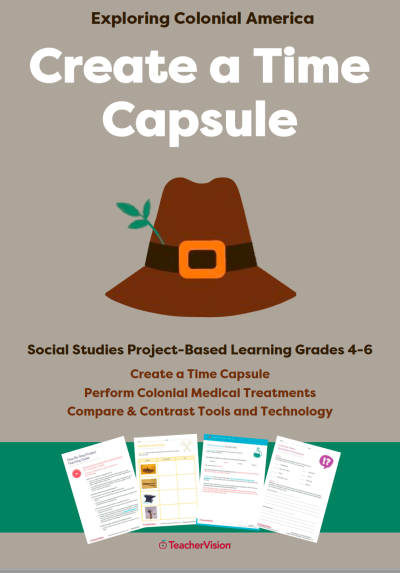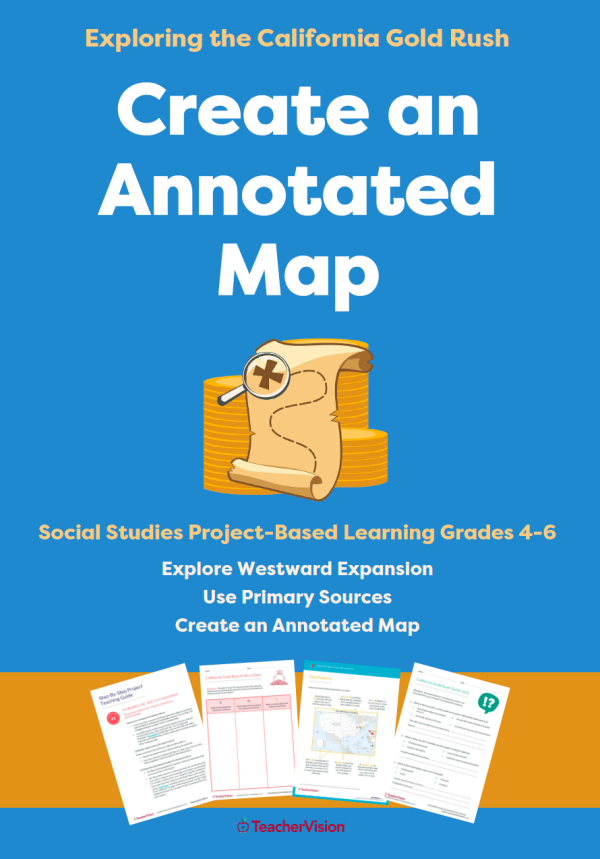
Included with a Premium Membership
Subscribe for instant access to this and every resource on TeacherVision.
A Comprehensive Lesson on Westward Expansion, Mapping, and the California Gold Rush
Learn about the push for westward expansion, use primary sources to document the California Gold Rush, plan and map a route West that mitigates the dangers and hardships, explore the "boom and bust" cycles that produced boomtowns, and synthesize that knowledge by designing and presenting an annotated "storytelling" map about the hopes and dreams of a journey West during the Gold Rush.
Your students will learn all about westward expansion in the United States while applying mapping, research, and descriptive writing skills in this complete project-based learning unit on the California Gold Rush for grades 4-6 social studies. They'll learn all about and document the California Gold Rush using primary sources, explore the dangers and hardships of a journey West, discover and map the famous "boomtowns" created by rapid expansion and the search for gold, and then create and present an annotated "storytelling" map of a personal journey West to California to join the Gold Rush.
What's Inside
Packed with hands-on inquiry-based activities, extensions and enhancements, cross-curricular independent and group work, and engaging and interactive challenges, this 52-page project-based unit comes complete with:
- For the Teacher: A complete California Gold Rush Lesson Plan with step-by-step instructions for all activities, teaching tips, assessment guidance, and inquiry questions.
- For Students: A full-color Student Pack complete with all of the printables, photos, and instructions students need for the research, experiments and activities - just print (or share) and teach!
A complete, ready-to-teach Teacher Pack that includes:
- Teacher versions of all the student printables with step-by-step annotations and notes for teaching the California Gold Rush and westward expansion;
- Formative and summative assessments, answer keys, and a full project rubric;
- Instructions and guidance for the extension activities and project enhancements;
- Materials and resources lists, links to articles, videos, and primary source documents, plus additional resources for lecture and presentation.
What's Included
Lesson Plan - Step-by-Step Project Guide
- Milestone 1: Planning the Trip to California
- Milestone 2: Researching and Mapping Boomtowns
- Milestone 3: Hardships Traveling West
- Milestone 4: Primary Sources from the Gold Rush
- Milestone 5: Making Annotated Maps
Teacher and Student Resources
- Materials List for the Projects in this Unit
- Books About the California Gold Rush (optional)
- Gold Fever Webquest Activity and Answer Key
- California Gold Rush KWL Chart Handout
- California Gold Rush Viewing Guide Activity and Answer Key
- Planning Your Journey to California Activity
- Milestone #1 Inquiry Question Writing Prompt
- Map Features Handout
- Stake Your Claim Boomtown Research Activity
- My Boomtown Drawing and Design Activity
- California Gold Rush - California Map Features Activity
- Milestone #2 Inquiry Question Writing Prompt
- By Land or By Sea: The Trip to California Project Activity
- Plan Your Route to California by Sea Mapping Activity
- Plan Your Route to California by Land Mapping Activity
- Milestone #3 Inquiry Question Writing Prompt
- California Gold Rush Quick Quiz and Answer Key
- Primary Sources Activity and Answer Key
- Primary Sources Document Links Handout
- Researching Primary Sources Activity
- Milestone #4 Inquiry Question Writing Prompt
- My Journey to California Annotated Map Project
- My Journey to California Annotated Map Writing Prompt
- Milestone #5 Inquiry Question Writing Prompt
- California Gold Rush Summative Assessment and Answer Key
- California Gold Rush Project Rubric
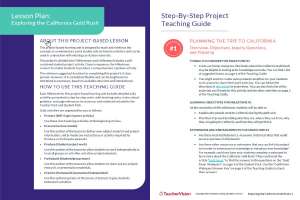
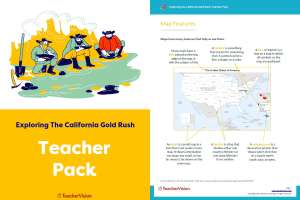
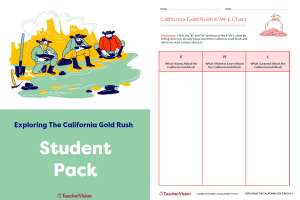
OVERVIEW:
This project-based learning lesson is designed to support and reinforce the concepts taught as part of a social studies lesson or unit on westward expansion and the California Gold Rush. It is built around 5 inquiry-based milestones that incorporate cross-curricular hands-on projects, formative and summative assessments, independent and group activities, and extensions.
STUDENT/GROUP OUTPUT:
In the course of this project-based learning unit, students will:
- Build background knowledge about westward expansion by planning a trip to California to join the Gold Rush;
- Use mapping skills and historical documents to research and map the famous "boomtowns" of California;
- Research and understand the hardships of traveling West by mapping specific routes over land and by sea;
- Use primary source documents from the Digital Public Library of America to research the history of the Gold Rush and westward expansion;
- "Show what they know" by using their research, mapping, and descriptive writing skills to produce an annotated "storytelling" map of a personal journey West to the Gold Rush.
SUGGESTED SUBJECT PREREQUISITES:
Students will acquire necessary background knowledge of westward expansion and the California Gold Rush as part of this project, and instructional materials for providing that background are included in the Teacher Pack. Students should be familiar with basic map reading skills and performing research.
SEQUENCE AND PACING
This project-based unit is divided into 5 milestones. The minimum suggested duration for completing this project-based unit is 5 class periods. However, the unit is completely flexible can be lengthened or shortened as necessary or desired, based on available class time and interest level.
TECHNOLOGY RESOURCES (suggested):
- Internet access
- Audio/visual equipment for listening to the song "Ho! For California"
STANDARDS ALIGNMENT
These activities support the following 3C Framework for Social Studies State Standards:
D1.5.3-5. Determine the kinds of sources that will be helpful in answering compelling and supporting questions, taking into consideration the different opinions people have about how to answer the questions.
D2.Eco.1.3-5. Compare the benefits and costs of individual choices.
D2.Eco.1.3-5. Identify positive and negative incentives that influence the decisions people make.
D2.Geo.1.3-5. Construct maps and other graphic representations of both familiar and unfamiliar places.
D2.Geo.2.3-5. Use maps, satellite images, photographs, and other representations to explain relationships between the locations of places and regions and their environmental characteristics.
D2.Geo.8.3-5. Explain how human settlements and movements relate to the locations and use of various natural resources.
D2.His.2.3-5. Compare life in specific historical time periods to life today.
D2.His.3.3-5. Generate questions about individuals and groups who have shaped significant historical changes and continuities.
D2.His.6.3-5. Describe how people’s perspectives shaped the historical sources they created.
D2.His.10.3-5. Compare information provided by different historical sources about the past
D2.His.13.3-5. Use information about a historical source, including the maker, date, place of origin, intended audience, and purpose to judge the extent to which the source is useful for studying a particular topic.
D3.1.3-5. Gather relevant information from multiple sources while using the origin, structure, and context to guide the selection.
D3.3.3-5. Identify evidence that draws information from multiple sources in response to compelling questions.
D3.4.3-5. Use evidence to develop claims in response to compelling questions.
D4.6.3-5. Draw on disciplinary concepts to explain the challenges people have faced and opportunities they have created, in addressing local, regional, and global problems at various times and places.



